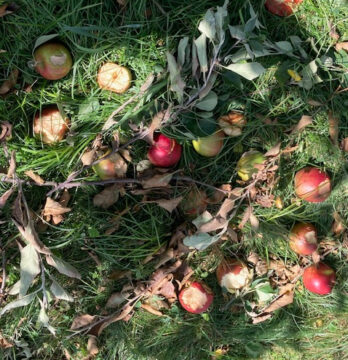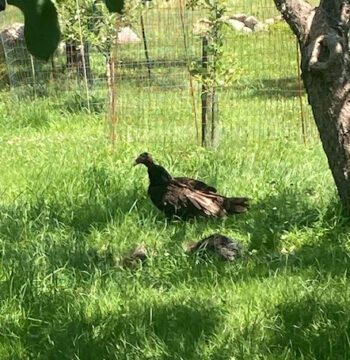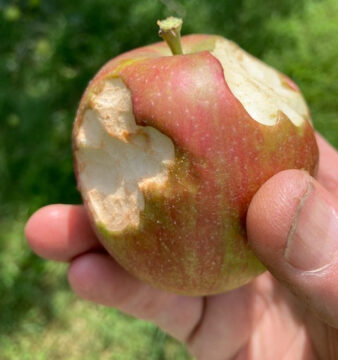by Mike Bendzela

I begin writing this essay the morning after dumping into the woods the sixth porcupine I have had to kill this growing season. It used to be that I would not see any evidence of porcupine damage in my apple trees until early August, but this year I began seeing chewed-off branches in late June. As with other ecological aberrations, it’s tempting to attribute the early arrival of porcupines in the orchard to a warming planet: We experienced a preternaturally early heatwave in mid-June in Maine, breaching 90 degrees on the 19th. Then it shot up to 96 degrees on the 20th, which is just weird. It stayed so hot through July that my onions and potatoes stopped growing and my broccoli failed to head up. All apple varieties are at least a week ahead of schedule this year. In the midst of this, I had to start my weekly scouting ritual extra early, going out into the orchard after midnight with a .22 pistol to deal with spiny rodents in the trees.
Why even shoot porcupines out of trees? It is undoubtedly a despicable practice, and I hate guns, but I can find no way around it. Porcupines love apple trees, and if left to themselves they will chew bark, branches and fruit until the trees are denuded of apples and permanently damaged. Then the well-fed porcupines will produce porcupettes, who will return to the orchard next season to continue the damage.
“Damage” is a matter of perspective. The porcupines are just doing what porcupines do — eat trees. They are rodents, with long, curving claws and incisors that continue to grow throughout their lives. The teeth are orange because they are literally iron-fortified. The animals can gnaw branches right off the trees and then descend to the ground to take bites out of apples. Sometimes they stay in the tree and go from apple-to-apple, gnawing and chewing. The damage they do is often shocking, but they are only doing to the trees what we humans do to lobsters — tear them to shreds and eat them.
Porcupines dine in the middle of the night, when they can remain in the trees invisible to predators. The first murder I committed at the end of June turned into a double murder. Usually, porcupines are quiet as stones and will remain utterly immobile on a branch if they know you are there. This time I heard the pipsqueak noises of a porcupine vocalizing. After shooting it, I walked through the orchard from tree-to-tree with a flashlight to see if I could find more damage; and when I returned to the site, I discovered a second porcupine there on a branch. It turns out the porcupine I had killed had been talking to its mate or a sibling. I dispatched the second porcupine then returned to bed. I would deal with their bodies in the morning.

Just after dawn, when I took my pickup with a shovel in back out to the orchard, I saw a buzzard already there to claim her breakfast. How did she know? The porcupines had only been dead a few hours. Nature continually startles me like that. Apparently, the olfactory systems of turkey vultures (buzzards in American parlance) are exquisitely tuned to detect ethyl mercaptan, a product of decomposition and the same stuff added to propane to make it stink. I shooed the carrion bird away and shoveled up the corpses to be dumped in the woods. The buzzards could dine on them there.
Porcupines, too, exhibit behaviors that I find uncanny. Ever since I began encountering them back around 2010, the porcupines have returned to the same spot every summer around the beginning of August (except for this year, when they began showing up in June). By “same spot” I mean literally the same tree! This tree sits directly in the middle of our single-acre orchard and is a heritage variety called Tolman Sweeting. It’s a not very attractive nor tasty apple, but we planted a few of these trees because they were listed on an original orchard map of this property dating back to the 19th century. The porcupines love this tree because the apples are sickly sweet; for this reason, Tolmans were often used as feed for livestock. But these apples don’t mature until the late fall, so why were porcupines returning to this tree during the summer when the apples were green? I don’t have an answer, but I suspect the sweetness of this variety extends into the wood of the tree itself, and perhaps the porcupines can smell sweetness the way the buzzard smells death and they home in on this tree every time. The porcupines gnaw the sweet wood to their hearts’ content, until I come along, that is.
Whenever I shoot a porcupine out of the Tolman Sweeting, it feels like I am shooting the same animal over and over. It is a strange and upsetting experience, like deja vu. I even feel I should capitalize its name to properly do it homage: The Porcupine. Every year, The Porcupine rises from the dead to return to the tree where it died the year before. I will even say to my husband before going outside with the pistol, “Well, The Porcupine is back in the Tolman again.” If left unchecked, The Porcupine will work its way through the orchard from the Tolman Sweeting to other trees. I have found it especially loves plum trees, and also another early, sweet variety of apple called Sops-In-Wine. That is the tree under which the sixth porcupine died just last night, and it still weighs on my mind.

The problem worsens year by year: The more housing developments displace woods nearby, and the healthier I keep my orchard, the more porcupines I have to deal with. I never get used to shooting them. So why am I doing this? I have tried other methods of getting rid of them, but these tactics are either ineffective or heinous. I’ve tried surrounding tree trunks with chicken wire, but this doesn’t dissuade them: They clamber right over the wire. In any case, I can’t put wire around all eighty trees in the orchard. I’ve put “have-a-heart” cage traps under the trees and baited them with apples and peanut butter, but the porcupines ignore the traps. That means I have never had to deal with trying to get one of these dangerous, spiny creatures out of a cage, not to mention the added absurdity of having to dispose of a porcupine I have “humanely” caught: Do I release it on someone else’s property? This is a question I ask myself every time I trap a woodchuck, a skunk, or an opossum. Why make it someone else’s problem? And I can’t imagine such an animal thriving in strange territory, either.
So, now I just use the pistol. At first, in order to save myself from having to rise multiple times during the night to discover the porcupines, I used leg-hold traps to keep them in place until the morning when I could shoot them, but I immediately saw how awful this method was and abandoned it. The trap keeps the animal tethered to a chain until I wake up to shoot it, which, as far as I’m concerned, is simply a form of torture.
It takes little skill to shoot a porcupine out of a tree: What takes skill is locating the animal with a flashlight in the darkness. As soon as it hears you, it becomes an inanimate, spiny statuette sitting amidst leaves. It will wait and watch you with black eyes while you draw a bead on it. Of course, such a stare penetrates to your core. If you are a thorough Darwinian, you see your likeness everywhere in the natural world, and you can’t help thinking about the great-great grandmother you and the porcupine share back in the Mesozoic. I’m careful not to wound the animal: Chasing after a porcupine waddling away injured is an experience I never want to repeat. While I can’t miss with a 20-gauge shotgun, it is bothersome to neighbors at 2 AM, as it makes a BOOM like a cannon. The .22 pistol just makes a pop — or multiple pops if I’m not steady-handed — that others may sleep through.
We have to kill to grow our crops. There is no denying this central fact of modern life. If ours were a five-hundred-acre orchard of high-density dwarf trees on trellis, we wouldn’t have this porcupine problem, because we would have eliminated its whole habitat. The interface between our domesticated world and the remaining wilderness is a catastrophe, an ongoing one at that. Just which species is the real pest in this situation?
I try to imagine what it was like when the most recent interglacial period began 15,000 years ago and our ancestors began shepherding their environment. I picture tribes in the Levant learning to guard native fields of precious wild grains, which they ground into flour or fermented for beer. They learned to rid the fields of saplings and other plant species, thus interrupting the process of ecological succession and creating a whole new concept, weed. They would likewise chase away ungulates that came to graze in the fields, pests.
Eventually, domestication would extend further than the barley fields. I imagine they immediately learned to corral the pigs that loved to feed on the wastes of their beer-making process and used them for meat. And who wouldn’t befriend the mewing felids that hung around grain storehouses looking for mice? Soon enough, Homo domesticus is speeding headlong toward ecological dominance and environmental rapine.
The principle of natural selection is turned on its head: The selected becomes selector, which selects only in terms of its own benefit, independent of ecosystems. Desire supplants fitness, and soon plant and animal varieties begin appearing that reflect not sound adaptation but one puny African ape’s tastes. As a result, whole habitats disappear, settlements expand, landlocked islands of crops become playgrounds for pest species. Diseases, infections, and parasites find new frontiers in the eyes, hearts, and minds of the apes who have unconsciously selected for their dispersal. As the chemistries of whole oceans and the atmosphere begin to shift, you can see the wisdom of Jared Diamond’s jeremiad, “The worst mistake in the history of the human race.” Agriculture is as much extermination as it is growing.
If the dark side of being a grower bothers me so much, why don’t I just abandon my orchard and start buying apples at the supermarket, which will happen anyhow as I age?
I would still be a murderer. I would have just farmed out the crime to someone else.
Human, thou art evermore a farmer, and God help thee.
Postscript: Seven porcupines as of the morning of August 23.
____________________
Images
Photographs by the author
Enjoying the content on 3QD? Help keep us going by donating now.
